Creative Teaching Resources for
by Robert C. O'Brien (1975)
Mrs. Frisby, a widowed mouse with four small children, is faced with a terrible problem. She must move her family to their summer quarters immediately, or face almost certain death. But her youngest son, Timothy, lies ill with pneumonia and must not be moved. Fortunately, she encounters the rats of NIMH, an extraordinary breed of highly intelligent creatures, who come up with a brilliant solution to her dilemma. In turn, Mrs. Frisby renders them a great service.
LitWits makes a small commission on anything you buy through our Amazon affiliate links.

Introduce your kids to the author, Robert C. O'Brien, who's low on the radar but lived such an interesting, too-short life! Did you know he wrote for National Geographic for decades? Many of his story descriptions and explanations sound much like how NatGeo reads. You might also talk about the way a hardship (glaucoma) led to good things (writing for children).
This short video is a great discussion starter, and we've got a worksheet for author note-taking. This helps kids notice the connections between his life and his book.
Set includes all worksheets and activity printables
A LitWits activity from the Exposition and beyond
The exposition exposes the setting and. main characters right up front—so let's get Mrs. Frisby and the rest of the major characters onto that farm first thing, in a visual, hands-on, artsy way!
SETUP
If you know what a collage is, you probably think of it as art, and it is. But it’s also a visual way of taking notes about the things that matter most—not just the characters and setting, but the bigger ideas each creature and thing represents. Images can bring some big ideas to a pretty small space. For instance, a tiny four-leaf clover stands for at least two big things: the idea of good fortune, and the country of Ireland.
SUPPLIES
farm backdrop + characters and objects from the story (in our printables set)
ModPodge
scissors
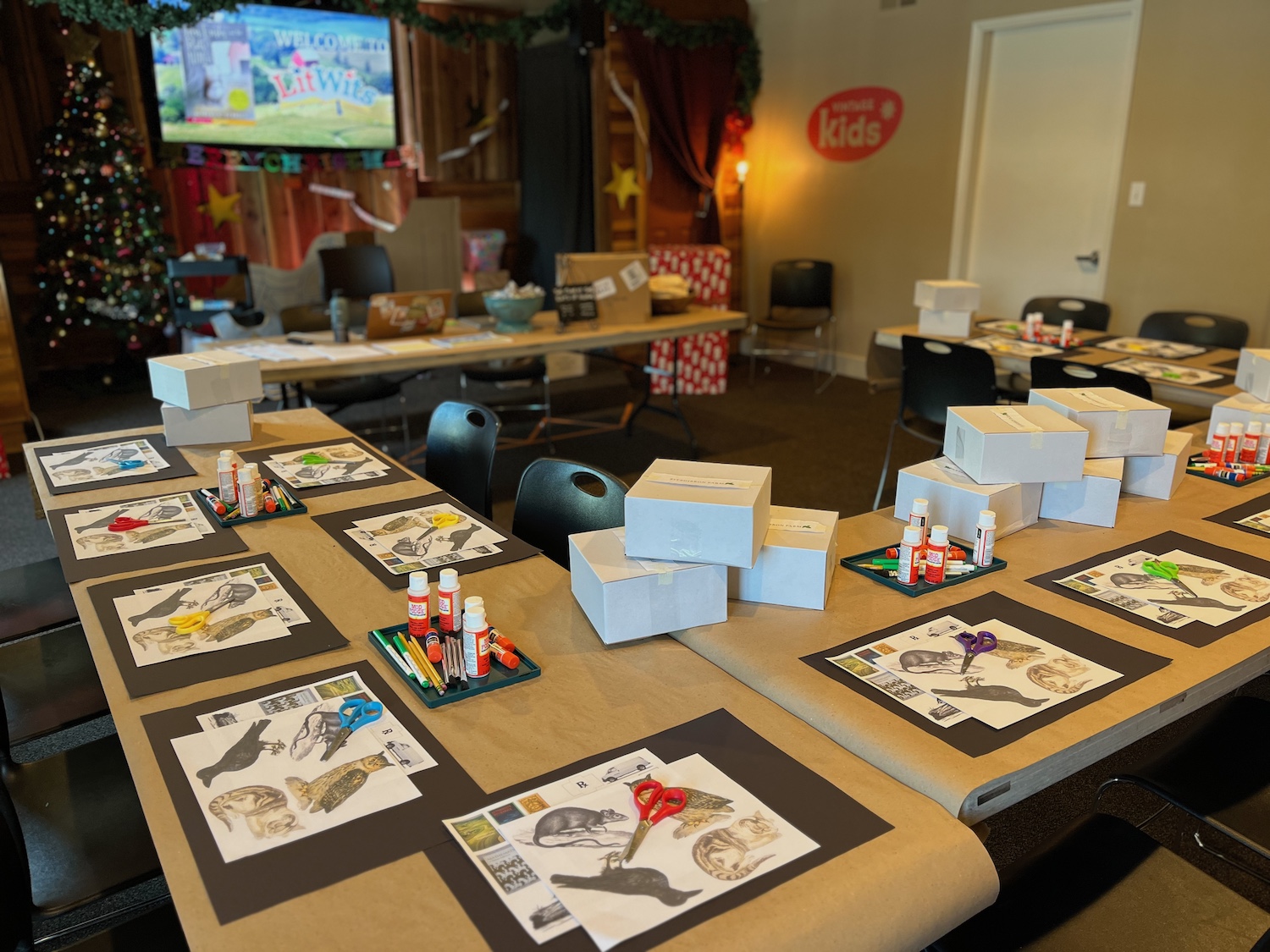
DIRECTIONS
Show some examples of collage art.
While the kids are cutting out the collage elements, talk about each creature and object—their attributes, purposes, and the assumptions made about each—and how the author used these connotations ("what something makes you think of") to enhance his story.
What do you think of as soon as you hear the word rat—or see one?
What about crows?
Mice?
Owls?
Point out that these connotations are the very reasons the author chose these creatures for his story.
Ask them what the objects might stand for:
What’s the meaning behind the two signs and the books? (control, self-determination)
What actions/ events do the van and Rx stand for? (Theft; loss of control; remedy; solution)
Set includes all worksheets and activity printables
BookBites
A LitWits activity from the Exposition
BookBites is the part of our literary experience when we get to “taste the story.” We choose a food right out of the book, and it has to be unusual, or important to a plot point, or have thematic significance. Ideally, it hits on all three.
We chose a food Mrs. Frisby found in the stump because it's both plot-centric and thematically significant, even if it is kind of . . . corny.
INSPIRATION
. . . It was, in fact, a yellowish-brownish-green: a bit of a corn shuck. . . she and her children were extremely fond of corn, and there were eight large ears in the stump, a noble supply for a mouse family. Down under the com she also could see a pile of fresh peanuts (from still another part of the farm), some hickory nuts, and a stack of dried, sweet-smelling mushrooms. . . with her forepaws and sharp teeth she pulled off a part of the husk from the top ear and folded it double to serve as a crude carrying bag.—"The Sickness of Timothy Frisby"
SETUP & MEANING
What's our first clue to Mrs. Frisby’s character? Yep, she's gathering food for her family, even though it's an icy morning and it’s dangerous out there in Cat Territory. What exactly does that tell us about her?
She's
responsible
brave
caring
observant
resourceful
dependable
intelligent
If a protagonist is tiny or weak, his or her character has to be HUGE. You already know she's going to be the hero—after all, this book isn't titled Timothy and the Big Plow! But this early-morning scene lets us know early in the story that Mrs. Frisby has what it takes. And it shows us how much she loves her family, so we sympathize more when she finds out she might lose her son.
Notice how much we learn about her by her behavior, choices, and words without being told. This is true of us all, in real life.. What we say and do tells everyone what we are like and what they can expect of us.
SUPPLIES
What is it she finds in the stump? (Dried corn! Among other things like mushrooms and peanuts.)
Why didn't the author have her find an old donut? (Her find was wholesome and natural and good for her kids, just like her)
And what does she ingeniously use to take it home? A corn husk!

Sounds like it's time for BOOKBITES!
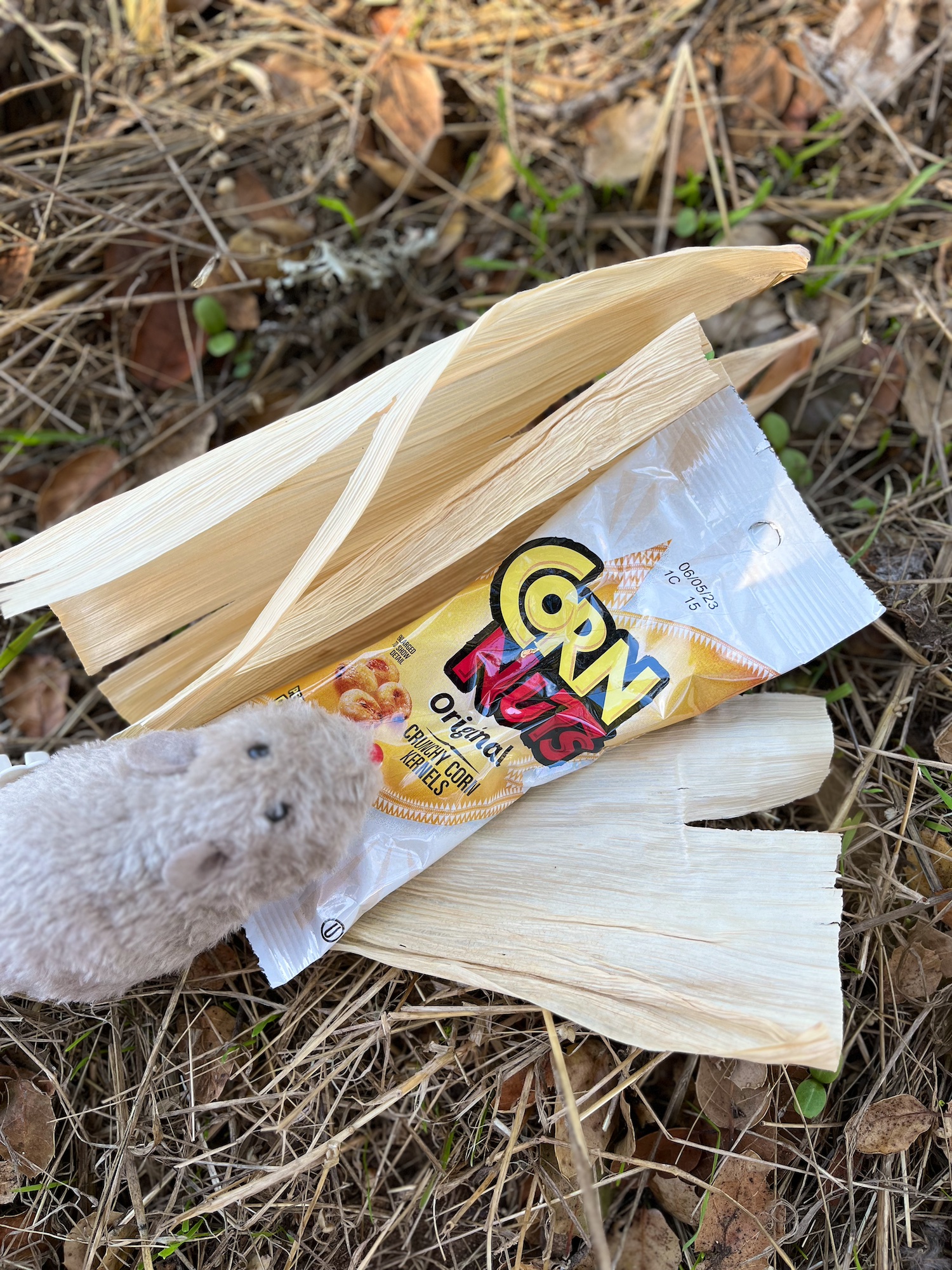
Since this story couldn't have happened if Mrs. Frisby hadn't had such fine character attributes,we've invited her to join us at our BYOC party. Looks like she's recently found a fresher stash!
A LitWits activity from the Conflict
While the kids replicate Nicodemus's drawing, you have a good chance to talk about the importance of turning a vision into a plan.
SETUP
The Frisby home is in the path of the plow, and Timothy’s too weak to move right now! OH NO!
Here’s what plowing looks like.
As you can see, a mouse house, even one made of cement, wouldn't stand up to that. So Mrs. Frisby bravely goes to the owl and then to the rats, as advised. To show her what the the owl had meant by "the lee of the stone," Nicodemus sketches a diagram of the garden, as seen from up in the air. This sketch leads to the plan that will save her home.
INSPIRATION
Mrs Frisby climbed up on the bench and looked at it. It was a rough map, showing the garden, the big stone near the middle, and the way the furrows made by the plough would curve around it, rather like waves around a boat.
‘Show me where your house is buried,’ said Nicodemus. Mrs Frisby pointed to the spot on the sketch. —“A Powder for Dragon"
SUPPLIES
Graph paper (or the worksheet in our printables)
DIRECTIONS & DISCUSSION
An idea without a plan is just an idea! So let’s put that idea into action ourselves by making that same sketch. Be careful with it—we're going to need it later!
While you're sketching, let's talk about a goal YOU have, and how you plan to achieve it.
What would the next step be?
Can you do that now?
If not, what needs to be done first?
Can you do THAT now?
If not, what needs to be done first?
Keep asking yourself these questions, until you arrive at something you CAN do now. Write down the questions and answers as you go; that document becomes The Plan. Take the first step you can, and then the next! Eventually, you'll be able—with help and persistence—to reach your goal.
Set includes all worksheets and activity printables
A LitWits activity from the Rising Action
One of the wonderful things about this story is the clear description of the Fitzgibbon farm layout—the garden, the rose bush, the position of Mrs. Frisby's cinderblock home. There's a satisfying level of design and planning that helps us visualize even the smallest details.
This project lets kids do their own designing and then build a miniature scale of the garden. It also gets their hands on the setting and situation, along with the resourcefulness of Mrs. Frisby and the intelligence of the rats.
(In phase 2, the activity "Home Safe Home," they'll get to move the cinderblock to "the lee of the stone," and then plow and plant the garden.)
SETUP
Now that we have a plan in hand, let's set up Mrs. Frisby's Big Problem in real life, with some real dirt and a real cinder block.
But first, you might want to show the kids THIS real cinder block that we found by the barn on our family farm while planning this workshop. Many decades ago, it too had fallen off the harrow. Really!
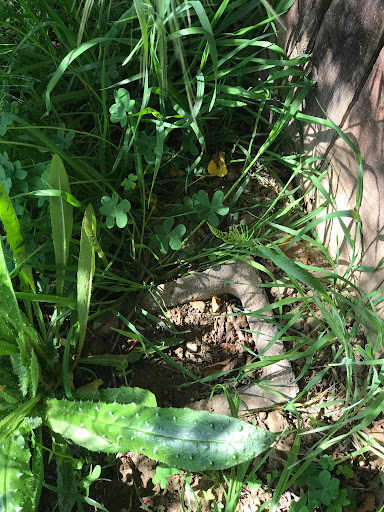

SUPPLIES for each child:
cardboard box (approx 12" x 12" x 4" but any size will do)
potting soil OR a block of coconut fiber, "expandable dirt" that's easier to distribute
a 2-3" rock, or buy lightweight rocks in bulk
cookie sheet with edges, to protect furniture—or do project outside
water
spoon
the cinderblock from our printables set, or buy real mini cinderblocks
scissors
glue
DIRECTIONS:
Turn the box over and poke 6 small holes with a pencil in the bottom of the box.
Put box on cookie sheet if you have one.
Fill the box 2/3 full with soil (or add a fiber block, if that's what you're using)
Pour water in to moisten the soil, stirring with the spoon; then pat down the soil.
Set the stone in the center.
Cut out the cinderblock and fold it into shape; tuck it beside the stone.
Now you've got the Fitzgibbon farm scene set up, and Mrs. Frisby's home is ready for saving! This activity will be continued with "Home Safe Home."
Set includes all worksheets and printables
A LitWits activity from the Rising Action
This imagination-boosting creative writing activity lets kids see things from Jenner's point of view, and write a passionate letter explaining his position.
In our workshops, we were touched by how many kids focused on forgiveness and compassion, and had Jenner be a survivor and/or the mysterious rat hero at the farm.
SETUP
Nicodemus told Mrs. Frisby he especially admired Jenner at the Farmer’s market, because he was “extremely quick and intelligent.” But Jenner resists the idea of moving to Thorn Valley. He sees nothing wrong with living an easy life, or in stealing what they need. When the colony votes to destroy the machinery and move, Jenner denounces them all as idiots and dreamers. Later, he and six of his supporters leave, presumably to set up a new (but still easy) life.
DIRECTIONS
Pretend you’re Jenner. Without assuming he’s the bad guy, think through his attitude and arguments as if they’re your own. Consider that he had some good points, and how you’d like him to turn out, and whether you want him to make up with Nicodemus or not.
Now write a passionate letter to Nicodemus from your new settlement, explaining why you had to leave, and what has happened since.
Set includes all worksheets and activity printables
A LitWits activity from the Rising Action
This vocabulary maze helps kids find their way through some new words, just like those supersmartified uh-MAZING rats did.
INSPIRATION
“When you’ve lived in a cage, you can’t bear not to run, even if what you’re running towards is an illusion.” -"In the Cage"
SUPPLIES
vocabulary worksheet (in our printables)
SETUP
Mazes are an important part of Mrs. Frisby and the Rats of NIMH. At the farm, the rats’ tunnels are a kind of maze. In the lab, the rats’ ability to learn was tested in electrified mazes; when they planned their escape from the lab they explored its air ducts, which Nicodemus called “a maze to end all mazes.” Mazes are about getting your bearings, and learning where to go and not go.
So let’s learn some of this story’s vocabulary words by working through a maze of our own!
AFTERWARD . . .
Now that you've made it through and learned some new words, your reward is not cheese but this funny video about rats and humans competing in parallel mazes!
Set includes all worksheets and activity printables

A LitWits activity from the Rising Action
Good question! Have the kids work it out by holding a debate. Team Jenner will explain and defend the idea of staying and living off the humans, and Team Nicodemus will argue the merits of moving to Thorn Valley.
The kids can refer to the chapter "Thorn Valley" for points already made by both sides, but they should definitely add their own.
Allow rebuttals and encourage Team Jenner not to be shy about standing up for their cause! In our workshops, we've heard some excellent arguments on both sides.
A LitWits activity from the Resolution
In this second phase of the "Fitzgibbon Farm" activity, Mrs. Frisby saves her house (and her SON!) from the plow. Sure, the rats helped. But if she hadn't bravely gone to them and ASKED, and if she hadn't passed along that vital info about the exterminators, nothing would have happened—nothing but death and destruction!
Talk about a hero! We love that this tiny little female ends up saving not only her son but the entire colony of rats, by her own wits and courage.
DIRECTIONS & SUPPLIES
First, move the cinderblock (in our Fitzgibbons-Farm-in-a-box) to the lee side of the stone, referring to the sketch made.
Then "plow" the farm with a pencil and plant some seeds!
Next, cut the Fitzgibbon Farm seed packet from our printables.
Decorate both sides with an illustration of the vegetable or herb that was planted. Fold it in half and glue it to the top half of a toothpick.
Stick the seed sign in the garden!
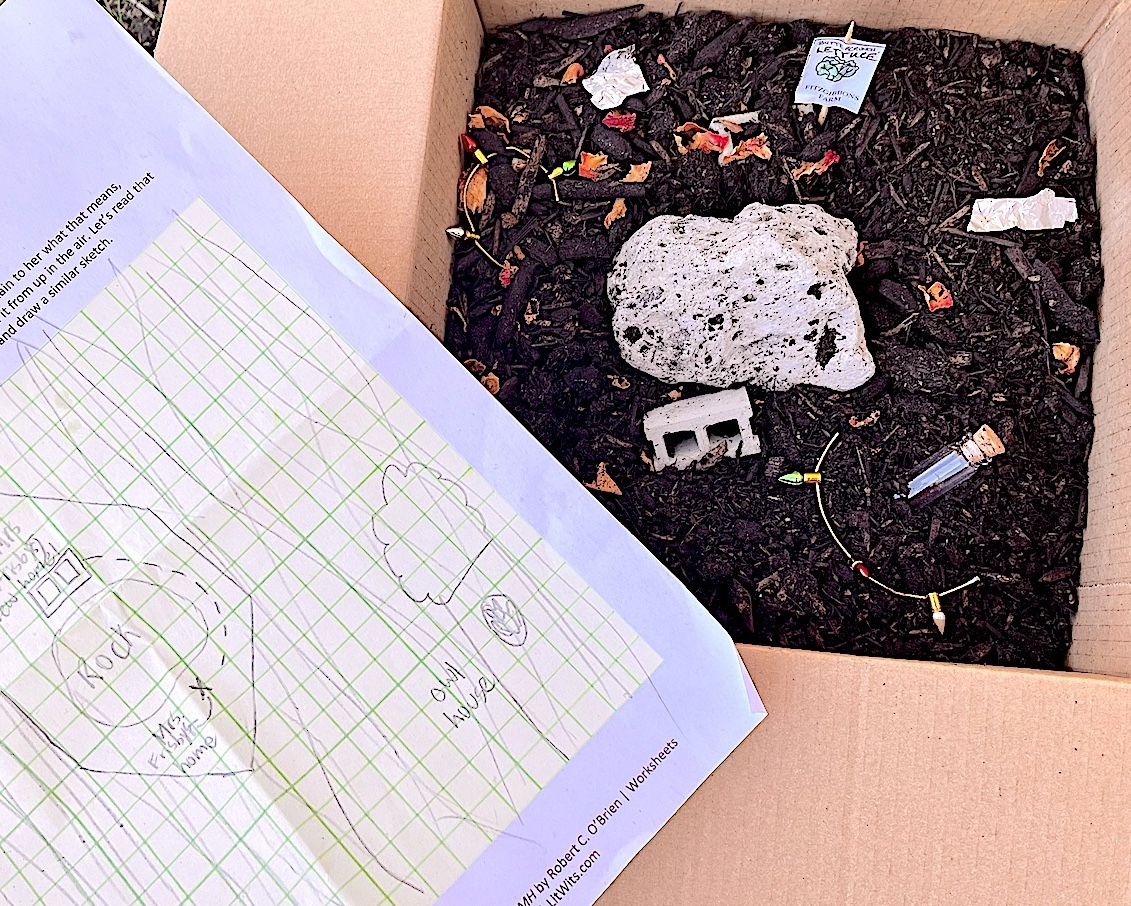
Optional Details
You might want to include some small just-for fun items to make the farm look like it might have after the rats have left and the field has been tilled… we packed them up in a test tube to emphasize the sciency/lab aspect of the book:
tiny piece of tin foil (to lure Jeremy back)
dried rose petals to scatter where the bush used to be
tiny vial that in the book held the antidote to the poison gas, and now holds the seeds for the garden. l
Scatter these story scraps around the garden, as if the plow had upturned remnants of the rats' home. Sprinkle rose petals where the bush once was, and tuck some light bulbs here and there. Put some shiny foil in the plowed field to get Jeremy's attention, in case the Frisby kids want to fly to Thorn Valley to visit the Rats!
Set includes all worksheets and activity printables
A LitWits activity from the Resolution
You can't read this book and then pass up the chance to have a rat race—and a MECHANIZED rat race, at that! This activity's just for fun, and well worth the few minutes it takes.
INSPIRATION
The story was part of a book of essays, and the reason I had read it so eagerly was that it was called “The Rat Race”— which, I learned, means a race where, no matter how fast you run, you don’t get anywhere. But there was nothing in the book about rats, and I felt bad about the title because, I thought, it wasn’t a rat race at all, it was a People Race, and no sensible rats would ever do anything so foolish.
And yet here we were, rats getting caught up in something a lot like the People Race, and for no good reason. And the worst thing was that even with our make-work projects, we didn’t really have enough to do. Our life was too easy. —"Thorn Valley"
SETUP
Have you ever heard of "The Rat Race" that Nicodemus had read about? A rat race is when people spend a lot of time doing unimportant things to try and be better than someone else, or some other group.
Since the term "The Rat Race" comes up in the story, AND the local paper calls the six dead rats "mechanized," we just HAVE to have a mechanized rat race, don't we?
We'll just have to rewrite the headline "Mechanized Rats Invade Hardware Store," as "Mechanized Rats Race Across Gym Floor!"
The worksheets and printables used for our activities are sold as a complete set.
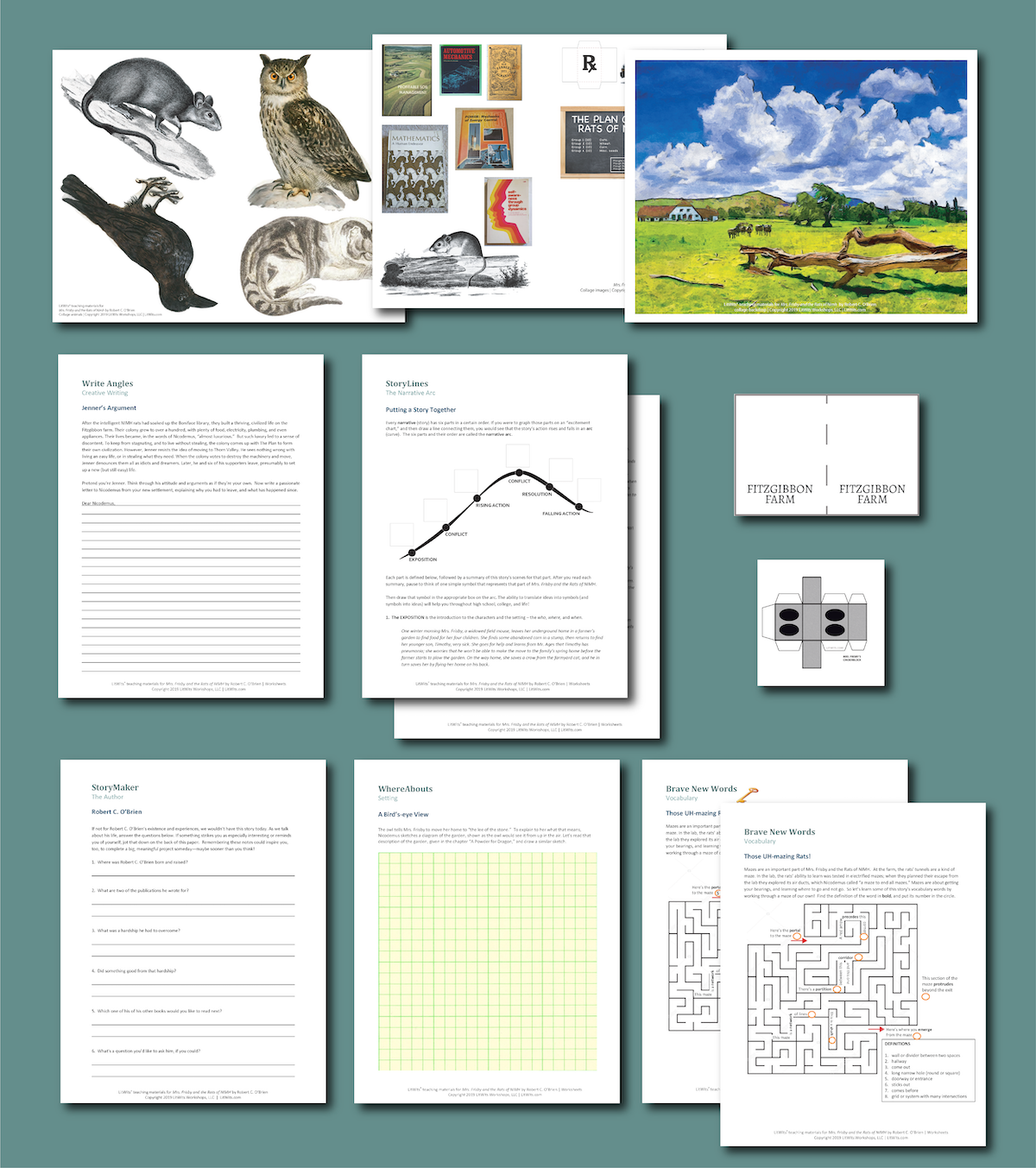
Common Core State Standards Alignment for the comprehensive use of our teaching ideas and materials is also included for grades 3, 4, 5 and 6.
Join our email list and we'll send you a code for $4 off all printables!
Set includes all worksheets and activity printables
This book is packed with important takeaway topics, which we're sharing below. In our workshops, we did our best to make these teaching points tangible, meaningful, and memorable in the kids' hands.

Takeaway 1
This story offers many examples of animals working together, which often includes planning:
Mrs. Frisby and Jeremy doing acts of kindness (and salvation!) for each other
all animals putting aside differences to work together against the cat
the rats working with Mrs. Frisby, and she with them
Jenner NOT collaborating any more, and leaving "the team"
the rats working together throughout the story (and backstory), from the start:
It was obvious that they knew exactly what they were doing, and they looked as well drilled as a group of soldiers. They had about twenty-five yards to go to reach the rosebush; as if at a signal (which, however, she was too far away to hear), they would all pull together, moving the wire about a foot. Then they would pause, rest, and heave again. -"Five Days"

Takeaway 2
“By teaching us how to read, they had taught us how to get away.” -"The Air Ducts"
Reading is the ticket to FREEDOM—not just for the rats but for all of us, figuratively speaking. Once they know how to read, they break through boundaries. And the more they read, the more they lose any desire to go back to a ratty life.
But the greatest treasure of all, for us, was in the study. This was a large rectangular room, with walnut panelling, a walnut desk, leather chairs, and walls lined to the ceiling with books. Thousands of books, about every subject you could think of. There were shelves of paperbacks; there were encyclopaedias, histories, novels, philosophies, and textbooks of physics, chemis¬ try, electrical engineering, and others, more than I can name. -"The Boniface Estate"

Takeaway 3
While this book emphasizes giving help, it also discourages prolonged dependency. The argument between Jenner and the others comes down to one of independence versus dependence. Their conversations make us think about the application to each of us as individuals, too.
“I say, why start from nothing if you can start with everything? We've already got a civilization.'
'No. We haven't. We're just living on the edge of someone else's, like fleas on a dog's back. If the dog drowns, the fleas drown, too.” -"Thorn Valley"
See our curated Learning Links for more tangential teaching opportunities, and to see how we brought this book and its ideas to life.
Explore these links to supplement your reading experience, research points of interest, and prompt tangential learning opportunities.
About the Book & Author
"Rediscovering anew the delights of ‘Mrs. Frisby and the Rats of NIMH’ - David King, The Georgia Bulletin
Reader reviews - Amazon (affiliate link)
Reader reviews - Common Sense Media
Story Supplements
About mice (for kids) - Britannica Kids
About rats (for kids) - Britannica Kids
"The girl who gets gifts from birds" - BBC
"The Early History of the Lab Rat" - Tyler Judd for Eureka
“Alternatives to Animal Testing” - NCBI medical journal article
The real NIMH - Office of Laboratory Animal Welfare (National Institute for Mental Health)
New Language Discovered: Prairie dogese -Jad Abumrad, Robert Krulwich, Morning Edition, NPR
When choosing props for our live workshops, we always try to focus on two important categories: props that are unique to the setting, because they help kids understand “what that was like,” and props that are symbolic of themes, because they make big ideas visual and tangible. Both kinds of props generate those wide-eyed, “aha!” moments.
You could easily have your kids contribute items to a table over time, as the book is being read.
Sometimes we create a printable prop; click the button to see the list for this book.
Set includes all worksheets and activity printables
Mrs Frisby, the head of a family of field mice, lived in an underground house in the vegetable garden of a farmer named Mr Fitzgibbon. -"The Sickness of Timothy"
‘I know where that cement block is,’ said the rat named Arthur. ‘In fact, I thought about bringing it in, but I decided it was too long a haul. They had it tied on top of the harrow for weight, and it fell off just as they were finishing the garden.’ -"A Powder for Dragon"
We just happened to find one buried next to our barn—it too had been used to add weight to the harrow.
She looked down the fence and saw that it was no hen at all, but a young crow, flapping in the grass, acting most oddly. -"The Crow and the Cat"
‘Go there. You will find a sentry guarding the door. His name is Justin. Tell him who you are, and that you came at my request. Tell him that you want to see a rat named Nicodemus. -"Go to the Rats"
In that rosebush, concealed and protected by dense tangles of fiercely sharp thorns, was the entrance to a rat hole. All the animals knew about it and were careful to stay away. -"Five Days"
There was, instead, a blackboard, covered with words and numbers written in white chalk. There were pieces of chalk and an eraser in a rack at the bottom of it. [ . . . ]. At the top of the board, in large letters, were printed the words:
THE PLAN OF THE RATS OF NIMH. -"In the Library"
Justin was wearing a satchel like Nicodemus’s, and from it he took a small paper package. ‘Here’s Dragon’s medicine,’ he said, putting it on the table. -"The Main Hall"
From a birdcage, Mrs Frisby watched the Fitzgibbons eat dinner. There was dinner for her, too - breadcrumbs, cheese, and bits of carrot - on the floor of the cage, along with a small bowl of water. -"Seven Dead Rats"
'In there’ - he gestured towards the last bin in the row — ‘we have boxes of seeds. Seeds for tomatoes, beets, carrots, melons and a lot more.’ -"The Main Hall"
But the greatest treasure of all, for us, was in the study. This was a large rectangular room, with walnut panelling, a walnut desk, leather chairs, and walls lined to the ceiling with books. Thousands of books, about every subject you could think of. There were shelves of paperbacks; there were encyclopaedias, histories, novels, philosophies, and textbooks of physics, chemis¬ try, electrical engineering, and others, more than I can name. -"The Boniface Estate"
What we did, after some discussion, was to find some equipment: first, a large spool of thread in one of the cabinets where some of us had seen Julie place it one day; second, a screwdriver that was kept on a shelf near the electric equipment... -"The Air Ducts"
The Becky & Jenny version: Feel free to print pages for teaching use, and make copies of printables for your students. Please don’t use our name, ideas, or materials commercially or share our printables, though we'd love for you to share these free pages with your fellow educators.
The blah legal version: You are granted exclusive use of our products in download or print version as follows: You have the right of reproduction that is limited to your use only in whatever quantity is necessary to meet your needs and those of your student participants. This right is unlimited and extends for as long as you need the materials during which time they cannot be given to or shared with any other person(s) through any means of delivery, materially or digitally via the Internet. As such you have the right to store the product(s) on the hard drive of your computer or as hard copy in your resource file. Any misuse of these rights is in violation of copyright law.
LitWits® is a registered trademark of LitWits Workshops, LLC.
LitWits® teaching materials for Mrs. Frisby and the Rats of NIMH by Robert C. O’Brien
Copyright 2019 by LitWits Workshops, LLC. All Rights Reserved.